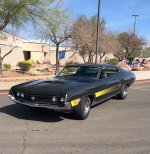Ghost Magnum
Member
I started going through the part numbers on my 427. I always known ford FE parts numbers list was a mess. But this is insane. My crankshaft says 3U. Digging through fords parts numbers list and found this crankshaft is a 390 stroke truck crank made after 1973.
The rods are forged from the late 60s. Possibly cobra jet rods. The timing chain cover is 1967 cast iron truck.
The biggest offender is my 427 block itself. I noticed there is ribs on one side of the block and no part number. After some digging on the internet. I found this could be a over the counter engine block. I found a P cast into the rear of the block. I found a picture of a vintage parts catalog saying that the P means extra phosphorus in the mix. And this is a performance block that was made after 1970. It should also be stronger then production block.
This is supposed to be a Chris Craft engine out of a pare. The guy I bought this from showed me some of the parts that came off of it.
One possibility is some time in the boats life. One of the 427s failed or froze. The owner bought a new block and crankshaft and transfered all the parts from old block to the new one. But I'm having a hard time believing someone would spend a ton of money buying a expensive engine block, and building it for a boat. It would be cheaper to just buy a used engine.
Another possibility is at the time that since some of the parts dated in the early 70s. Ford was in the process of fazing out the big block FE family for the 429/460. Ford has just dropped out of racing and dealing with new regulations. They probably had some orders to fill for Chris Craft. So ford probably just literally used whatever parts that was within arm's reach and sent it to Chris Craft.
Or, it's all meaningless. The numbers mean nothing. This is just what ford did what ever year this chris craft motor was assembled. And I'm way over thinking it.
This is most definitely a 427 cast as a side oiler. It has the bosses, side bolt mains and screw in freeze plugs. A 427 FE is a 427 FE. So I'm still happy I have it.
The rods are forged from the late 60s. Possibly cobra jet rods. The timing chain cover is 1967 cast iron truck.
The biggest offender is my 427 block itself. I noticed there is ribs on one side of the block and no part number. After some digging on the internet. I found this could be a over the counter engine block. I found a P cast into the rear of the block. I found a picture of a vintage parts catalog saying that the P means extra phosphorus in the mix. And this is a performance block that was made after 1970. It should also be stronger then production block.
This is supposed to be a Chris Craft engine out of a pare. The guy I bought this from showed me some of the parts that came off of it.
One possibility is some time in the boats life. One of the 427s failed or froze. The owner bought a new block and crankshaft and transfered all the parts from old block to the new one. But I'm having a hard time believing someone would spend a ton of money buying a expensive engine block, and building it for a boat. It would be cheaper to just buy a used engine.
Another possibility is at the time that since some of the parts dated in the early 70s. Ford was in the process of fazing out the big block FE family for the 429/460. Ford has just dropped out of racing and dealing with new regulations. They probably had some orders to fill for Chris Craft. So ford probably just literally used whatever parts that was within arm's reach and sent it to Chris Craft.
Or, it's all meaningless. The numbers mean nothing. This is just what ford did what ever year this chris craft motor was assembled. And I'm way over thinking it.
This is most definitely a 427 cast as a side oiler. It has the bosses, side bolt mains and screw in freeze plugs. A 427 FE is a 427 FE. So I'm still happy I have it.


